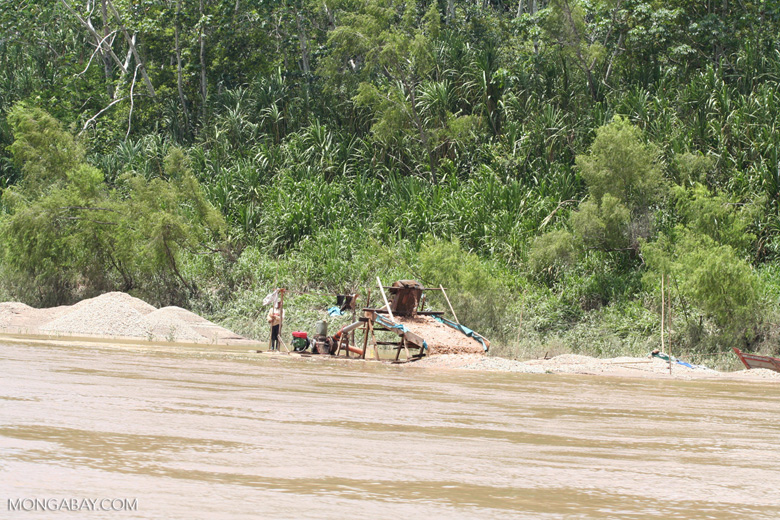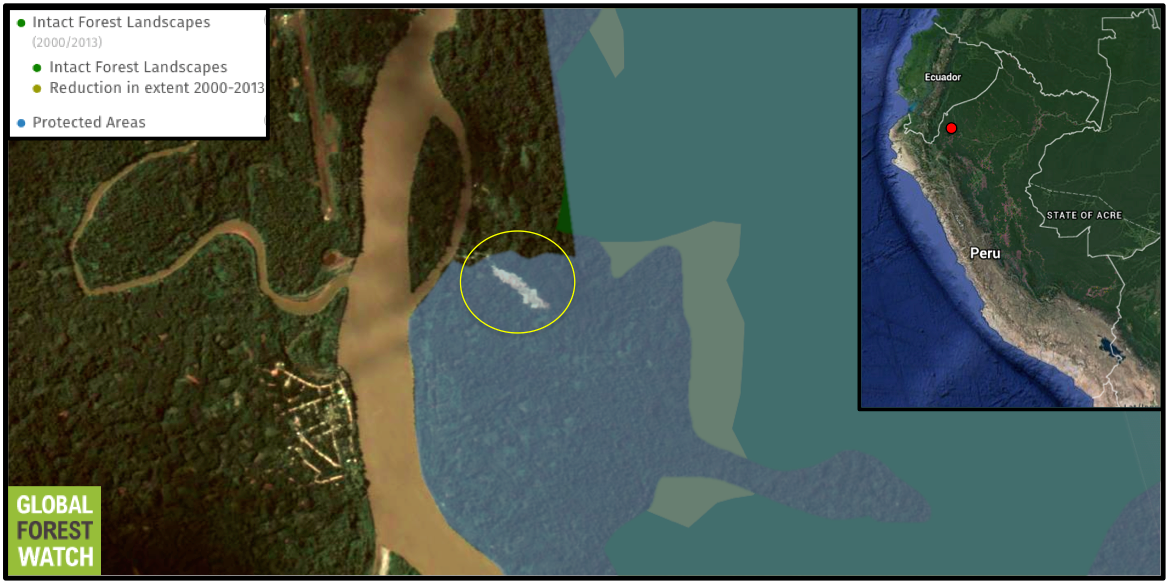- Illegal gold mining is rampant in many areas of southern Peru, driven by rising gold prices.
- Now, for the first time, researchers have detected gold mining-related deforestation in northern Peru. The deforestation occurred along the Santiago River in the buffer zone of a protected area, and near intact forest.
- Most of the forest loss occurred between August 2014 and August 2015. However, satellite data indicate deforestation may be ongoing, with more tree cover loss detected in March 2016.
- In addition to deforestation, gold mining has been linked to mercury poisoning, river alteration, and crime.
Satellite images released last week revealed evidence of the first known case of deforestation caused by gold mining in northern Peru. Occurring in Peru’s Condorcanqui Province in the Amazonas region, gold mining operations are expanding along the Santiago River, as well as creeping into and displacing neighboring forest.
High-resolution images of areas recently deforested due to mining activity along the Santiago River, indicate that eight hectares (20 acres) of forest has been lost so far — an area the size of 12 soccer fields. These satellite images, published by Monitoring of the Andean Amazon Project or MAAP, a project of the Amazon Conservation Association and ACCA-Conservacion Amazonica, show that this deforestation occurred between August 2014 and August 2015.
The Regional Organization of Indigenous Peoples of the Peruvian Amazon in northern Peru, better known as ORPIAN, claims illegal mining threatens the nearly 70,000 residents of the indigenous Awajun and Wampis communities living in the Santiago region. President of ORPIAN, Edwin Montenegro, believes illegal mining is on the rise in the region and is not being monitored.

In April 2016 on ORPIAN’s invitation, Esteban Valle Riestra, a consultant with Lima-based non-profit DAR, and a colleague travelled to the Amazonas region, where they documented gold mining activity.
“We heard about the spreading of illegal mining from Madre de Dios to other Amazon areas,” Riestra told Mongabay. “However, the rumours were restricted to the southern regions, mostly to Puno, closer to the Bolivian border. It would be odd [to] see this activity so far to the north, we assumed. Therefore, we agreed to go with one native guide on a boat to the nearest mining camp to take pictures and videos.”
Describing the visit, Riestra said, “There, sailing through one of the stream of Santiago river, called “Pastasio” or “Pastacillo” by the locals, we [saw] a large portion of cleared land – maybe half a mile long of forest razed and 10 to 15 miners working there. That spot has been growing fast since the past years. As we could see from the pictures provided by MAAP, the portion of forest lost is up to 20 acres now.”
The distinction between informal mining and illegal mining is blurry at best in Peru, according to Riestra, but in this case, there are two mining concessions in the Pastacillo area. Riestra says Montenegro believes that miners are extracting the mineral without permission and that no official company is working in that area.

Peru is the biggest gold producing nation in Latin America, as well as one of the world’s largest producers, exporting its gold to countries like Switzerland, Canada, the U.S., India and the UK. According to a 2015 report, from 2000 to 2012, mining in this region increased by 400 percent. Gold mining has a notorious record in Peru, widely recognized as a major driver of deforestation. Satellite images of Peru’s Madre de Dios region have shown mining is leading to forest loss even within protected areas and changing the courses of rivers.
Of its gold production, illegal mining has grown significantly in the past decade. A 2015 report by Lima-based NGO CooperAccion found that illegal mining accounted for around 10 percent of Peru’s gold mining activity in 2006, rising to a high of 29 percent in 2011. This increase was driven in large part by rising gold prices, claims Victor Torres Cuzcano, author of the report and an economist at Peru’s National University of San Marco. From 2006 to 2012, the price of gold nearly quadrupled. After a three-year decline, prices again look to be on the rise, rising steadily since the beginning of 2016. This increase has corresponded with a jump in mining activity in many areas of southern Peru and now into its northern region.
Illegal gold mining in Latin America appears to be increasingly controlled by drug traffickers and organized criminal groups, according to a report by NGO Global Initiative Against Transnational Organized Crime (GIATOC). This report found that 28 percent of all gold in Peru is illegally mined and approximately 35 tons of contraband gold worth over a billion dollars entered the U.S. and Switzerland within just nine months in 2014.

The report also cites research that shows more than 30 tons of mercury are being dumped into Peru’s rivers and lakes every year. Mercury causes gold particles to glom together, and is commonly used to separate gold ore from surrounding sediment. However, mercury is toxic even in small quanitities, and is linked to birth defects, neurological disorders like Minamata disease, and even death. Calculations published in 2015 show that every year 40.5 metric tons of mercury enters the Madre de Dios River, one of Peru’s most important water bodies and a major tributary of the Amazon River. The United Nations Environment Program’s Global Mercury Assessment of 2013 shows small-scale and artisanal gold mining is the second largest contributor globally to mercury pollution.
Numerous investigations have also linked illegal gold mining to child labor, human trafficking, violence, land grabbing, forced labor, and myriad other illegal activities.
And now, organizations like ORPIAN are worried that their thus-far spared Santiago River Basin may be on a rapid downward spiral illegal mining continues to spread into the region.
“It is certainly a huge environmental threat that is not being properly assessed by the authorities,” Riestra said. “Although the native communities are worried about the possible consequences of this activity, the local government (hasn’t estimated) the scale of the problem or taken any action yet.” Furthermore, he says, this inaction mirrors the failure of the Peruvian state to successfully tackle illegal mining. “The policies drawn so far [have] been ineffective in controlling the spread of this activity around the country.”


Lack of governmental awareness isn’t the problem, Riestra said, mentioning that in 2014 and 2015 police destroyed 15 to 20 dredges along the Santiago, which are used to extract gold from sediment. However, he said that no further action has been taken to prevent the expansion of illegal mining in the area
The native communities’ stance on gold mining in the Pastacillo area is complex, Riestra said, and people are divided over the issue. “The majority (60 to 80%) [are] against illegal mining, worrying about the environmental consequences. But the rest see it as a legitimate source of profit and take part [in] the activity.”
It is important to note that the communities living in this area are very poor, Riestra said, and that they mostly live off agriculture and by selling traditional handicrafts. He added that the local youth have very few opportunities for sustaining a livelihood other than migrating to coastal cities.
But many others worry there will be more drawbacks than benefits to the spread of gold mining in northern Peru.
“Why don’t we want mining in this region?” Montenegro told the Guardian. “One, because the indigenous population don’t have running water. Our way of washing is using the river, the streams, and we drink from them too. That’s why it’s important that we can’t allow mining. [The miners] extract gold from the river, they put in the mercury, that’s what the fish drink, and then that’s what we could eat. That’s why there’s so much concern about it. In addition, they’re taking out trees, they’re chopping them down. The biological diversity, flora, fauna … All disappearing.”
Citations:
- Greenpeace, University of Maryland, World Resources Institute and Transparent World. “Intact Forest Landscapes. 2000/2013” Accessed through Global Forest Watch on July 7, 2016. www.globalforestwatch.org
- Finer M, Novoa S (2016) Gold Mining Deforestation in the Northern Peruvian Amazon. MAAP: 36.
- Hansen, M.C., A. Krylov, A. Tyukavina, P.V. Potapov, S. Turubanova, B. Zutta, S. Ifo, B. Margono, F. Stolle, and R. Moore. 2016. Humid tropical forest disturbance alerts using Landsat data. Environmental Research Letters, 11 (3). Accessed through Global Forest Watch on July 7, 2016. www.globalforestwatch.org
- IUCN and UNEP-WCMC (2016), The World Database on Protected Areas (WDPA) [On-line], Cambridge, UK: UNEP-WCMC. Available at: www.protectedplanet.net. Accessed through Global Forest Watch on July 7, 2016. www.globalforestwatch.org
